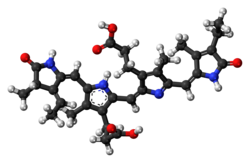Top Qs
Timeline
Chat
Perspective
Phycocyanobilin
Chemical compound From Wikipedia, the free encyclopedia
Remove ads
Phycocyanobilin is a blue phycobilin, i.e., a tetrapyrrole chromophore found in cyanobacteria and in the chloroplasts of red algae, glaucophytes, and some cryptomonads. Phycocyanobilin is present only in the phycobiliproteins allophycocyanin and phycocyanin, of which it is the terminal acceptor of energy. It is covalently linked to these phycobiliproteins by a thioether bond.
Phycocyanobilin (PCB), has the ability to bind to human serum albumin (HSA), protein found mainly in the blood of humans. This PCB-HCA complex benefits the structure of HSA, increasing the thermal stability of HSA, as well as increasing its ability to prevent against proteolytic activity of other proteins.[1]
Remove ads
Biosynthetic Pathway

The biosynthetic pathway of phycocyanobilin begins with 5-Aminolevulinic acid (5-ALA).[2] Two molecules of 5-ALA undergo a condensation reaction catalyzed by Porphobilinogen (PBG) Synthase to yield a molecule of Porphobilinogen (PBG) (not shown).[3] Four molecules of PBG are polymerized into a linear tetrapyrrole by Porphobilinogen deaminase. This reaction releases four ammonia molecules in the process. Completion of the tetrapyrrole is performed by Uroporphyrinogen III synthase which results in the macrocyclic Uroporphyrinogen III. Uroporphyrinogen III is then converted to a Heme by a Uroporphyrinogen III decarboxylase. The heme molecule is converted to Biliverdin IX α. Biliverdin is then finally reduced to Phycocyanobilin (PCB) by the Phycocyanin Ferredoxin Oxidoreductase PcyA. Literature circa 1989 includes phytochromobilin as an intermediate in this final conversion.[2]
Remove ads
References
Further reading
Wikiwand - on
Seamless Wikipedia browsing. On steroids.
Remove ads


